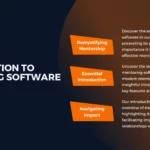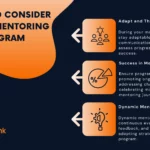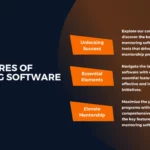
Mentoring 101: A Detailed Guide to Successful Mentoring
Mentoring is a long-standing institution that has influenced groups, created leaders, and transformed businesses. Fundamentally, mentoring involves guiding, developing, and imparting information from one person to another.
Whether in the bustling corridors of a modern corporation or the peaceful nooks of an academic institution, mentorship stays the same: it is an essential link between the present and the future, between what is and what could be.
In this guide, we will look at the many different aspects of mentoring, including definitions of mentor and mentee, purposes, types, and stages, as well as practical guidance for both mentors and mentees.
What is Mentoring?
The definition of mentoring can be given like that less-experienced or educated oneself, known as the mentee, obtains guidance and support from a more experienced or knowledgeable person, known as the mentor, through the relationship-building process of mentoring.
The collaboration frequently goes beyond only professional or academic limits, exploring personal growth and development. Mentoring is defined as a broad variety of activities, including giving guidance, sharing insightful knowledge, providing emotional support, and organizing networking opportunities. It is a mutually beneficial connection that enhances both the mentor and the mentee and promotes a culture of lifelong learning and respect.
What is the Purpose of Mentoring?
Empowering individuals to reach their highest possible achievement by assisting their professional and personal development is the main objective of mentoring. The goal of mentoring for mentees is to help them overcome obstacles in their careers, learn novel abilities, expand their professional circles, and obtain new perspectives in their chosen fields.
Conversely, mentors get a sense of fulfillment from helping to mold the next generation of leaders, contributing to their community, and frequently obtaining new insights about their own ways. Creating adaptive and resilient individuals who are prepared to handle the pressures of their jobs and make meaningful contributions to their industries is largely dependent on mentoring.
In the framework of mentoring, the goals are as varied as the individuals involved, ranging from long-term career goals fulfillment to ability learning, advancement in their jobs, and individual growth. In addition to helping people reach their goals on the personal and professional fronts, this dynamic connection fosters a supportive environment in which opportunities, expertise, and experiences are freely shared, thereby enhancing the mentorship.
Types of Mentoring
There are many different types of mentorship, and each has unique characteristics and benefits. Knowing such types can assist both individuals and organizations in designing their mentorship initiatives to fit certain requirements and objectives.
- Traditional mentoring: This is perhaps the most well-known type, in which a more experienced person (the mentor) assists a mentee having less expertise by offering advice and assistance. The mentee’s personal and professional development is the main focus of the relationship, which is often one-on-one and can last for several years.
- Reverse Mentoring: With this method, experienced team members are mentored by younger or less experienced staff members, inverting the conventional roles. This strategy works especially well in areas like social media, technology, and current trends, giving senior staff members access to the newest developments and cultural shifts.
- Peer Mentoring: Peer to peer mentoring takes place between people who are on the same level or having similar backgrounds. This kind can create a welcoming environment where peers can exchange information, work together to solve problems, and support one another.
- Virtual Mentoring: Through using technology, mentors and mentees can communicate beyond borders through virtual mentoring. Given its flexibility and increased accessibility to a larger network of mentors and mentees, this approach is growing in popularity.
Every kind of mentoring has a distinct function and works well in a certain setting. Reverse mentoring can help firms stay ahead of the curve, while traditional mentoring is crucial for profound, long-term professional growth. Virtual mentoring lowers barriers to mentorship, making it more accessible to all, while peer mentoring promotes a sense of community and shared growth.
A mentorship program can be made more effective by using these various forms of mentoring, which offer individualized assistance that is designed to fit the specific requirements and objectives of both mentors and mentees. There is a mentoring approach that suits any goal, be it skill improvement, job advancement, or personal development.
What Should a Mentee Do?
The success of a mentorship greatly depends on the mentee’s commitment and extent of engagement. The subsequent actions and mindsets are specific to what a mentee should do:
- Establish Specific Goals: Clearly state your objectives for both your professional and personal growth. Make sure the mentorship is centered on pertinent and significant results by identifying your areas of growth and sharing them with them.
- Be Prepared for the Meeting: Attend every meeting with a well-defined agenda, questions, or progress reports. This planning optimizes the benefit of your sessions and demonstrates consideration for your mentor’s time.
- Take Advice and Comments to Action: Show that you have dedication to heeding recommendations and criticism from your mentor. In your professional life, try out innovative tactics and techniques and share your findings.
- Be Open to Feedback: Welcome constructive criticism and use it as a foundation for growth and improvement from your mentor.
- Act on Challenges: Show courage by venturing outside of your comfort zone. Seek out difficult assignments or projects from your mentor to help you learn and develop more quickly.
- Increase Self-Awareness: Regular self-reflection can help you identify your skills and limitations as well as how the mentorship has affected your personal growth. To further customize your learning experience, discuss these realizations with your mentor.
If you want to get more information about other benefits of mentoring for mentees, you may read our blog post “How Mentoring Helps Mentees Develop Leadership Skills“.
What Should a Mentor Do?
The definition of a mentor can be explained as encouraging, assisting, and leading their mentee toward realizing their full potential. Successful mentor program on a regular basis does:
- Hand out Sensibly: Give guidance based on your own experiences and observations, taking into account the mentee’s goals and unique situation.
- Encourage a Secure Environment: Establish a trusting, safe space where mentees can freely express their worries, anxieties, and failures.
- Support Professional and Personal Development: Push your mentee to go beyond their present comfort zone. Motivate them to take on additional duties that complement their areas of growth.
- Track Development: Aid in establishing reasonable benchmarks and goals. Review progress on a regular basis and offer helpful criticism to maintain the mentee.
- Build Up New Networks: Introduce mentees to new individuals, suggest networking events, and expose them to other viewpoints in the field. This deepens their comprehension and creates new avenues for career advancement.
Mentors ensure that you are emotionally and professionally successful and competent in your business and career life. To get more information about career mentors you may also read Why is it Important to Have a Career Mentor? in our blog site.
What Should a Mentoring Software Do?
Mentoring software has to be thorough, easy to use, and supportive of the mentoring process in order to properly support the mentoring partnership. These additional characteristics are what such software ought to provide:
- Advanced Matching Algorithms: Making use of complex algorithms to match mentors and mentees according to a variety of criteria, such as individual interests, professional expertise, career objectives, and particular mentoring requirements. This guarantees a better chance of a good and effective mentoring connection.
- Setting and Monitoring Goals: Provide mentors and mentees the resources they need to use the platform to define precise, quantifiable objectives and benchmarks. Regular updates, reflections, and goal-adjusting should be possible with this functionality as the mentoring relationship develops.
- Integrated Interaction Methods: To make contact between mentors and mentees simple and efficient, provide a range of communication methods, such as file sharing, video conferencing, and messaging. Regular interactions should be scheduled with ease using these platforms, and they should facilitate ad hoc talks as needed.
- Resource Library: Provide an extensive collection of materials on a range of subjects related to mentoring and professional development, including instructional guides, articles, and educational modules. Both mentors and mentees should have easy access to and search capabilities inside this library.
- Mechanisms for Feedback and Evaluation: Put in place mechanisms for giving and receiving comments on the mentoring relationship. To guarantee open and useful communication, this may involve conducting frequent surveys, providing feedback forms, and offering the opportunity for anonymous comments.
- Community Attributes: Offer an environment within the software where mentors and mentees may exchange stories, pose inquiries, and gain knowledge from the larger community. Forums, Q&A sections, or group conversations might be used for this.
The Four Stages of a Mentoring Relationship
A mentoring program, regardless of its type, has a specific process. This process may differ for mentor and mentee. The four-part cycle of mentoring can be described as follows;
- Beginning
The mentor-mentee relationship starts out with this first phase, which is frequently characterized by enthusiasm and expectation. Both sides establish connection, talk about the objectives, and lay out what’s expected of them on the trip ahead. It’s an opportunity to establish mutual confidence and lay out the parameters of the mentoring, such as meeting schedule and preferred forms of contact. The tone for the entire mentoring process is established at this point.
- Growth
The mentee begins to make noticeable progress toward their objectives as the relationship develops, frequently trying new behaviors and approaches they have picked up from their mentor. Wider conversations, higher-level challenges, and increased effort from the mentee are characteristics of this phase. By offering direction, criticism, and support, the mentor aids the mentee in overcoming challenges and seizing new chances.
- Development
When the mentee has made substantial progress and the relationship has evolved into more of a collaborative interchange, the mentee enters the phase of maturity. As equals, the mentor and mentee can exchange perspectives, evaluating the mentee’s development and formulating future plans. A deep connection, respect for one another, and a sense of achievement define this stage.
- Finalization
The official mentoring relationship will eventually terminate, presumably as a result of the mentee having achieved their initial objectives. For the purposes of reviewing the voyage, acknowledging accomplishments, and making future plans, closure is an essential stage. It’s critical that mentor and mentee accept the termination of their official connection while thinking about possible ways to stay in touch on an informal basis.
Finding the Right Mentorship Program
Selecting an ideal mentoring program is a crucial phase in one’s own career and personal growth process. The ideal program offers an environment of encouragement that promotes learning, growth, and genuine connections in addition to being in line with your professional aspirations. To help you along the way, below is a thorough overview:
- Set Your Objectives: To begin with, determine precisely what you expect of getting from the mentoring partnership. Do you want to grow your professional network, acquire new skills, or progress in your career? Finding a program that aligns with your goals will be made easier if you know what your objectives are.
- Conduct Detailed Investigation: Examine all of the mentorship programs that are offered. Seek out opportunities via internet resources, professional groups, or your place of employment. Examine case studies, endorsements, and evaluations to determine the program’s effectiveness and impact.
- Evaluate the Matching Process: The process of matching mentors and mentees is essential to ensuring the success of any mentorship program. A program that is successful matches participants based on a thorough and deliberate approach that takes into account their goals, interests, experience in the sector, and personality fit. By doing this, a positive and productive mentor-mentee connection is ensured.
- Think about the Program Structure: Evaluate the program’s presentation and organization. Does it provide group workshops, one-on-one coaching, or both? Recognize the needed degree of commitment, including the time obligations and the length of the mentoring.
- Support and Resources: Seek out initiatives that offer a wide range of resources and assistance. This might involve goal-setting and progress-tracking tools, mentor and mentee training sessions, and access to a larger community for networking and support.
Things to Consider Before and After Starting a Mentoring Program
To maximize the benefits of mentorship, here are key considerations before starting and after concluding a mentoring program:
Before Starting
- Self-Assessment: Reflect on your strengths, weaknesses, and areas where you seek growth. This self-awareness will guide your interactions and goal-setting with your mentor.
- Set Clear Goals: Articulate what you wish to achieve from the mentorship. Clear goals provide direction and help measure the success of the mentorship. Setting clear goals are also about the goals of mentorship programs.
- Openness to Learning: Approach the mentorship with an open mind and readiness to learn and be challenged. The willingness to step outside your comfort zone is crucial for growth.
After Completing
- Reflect on the Experience: Take time to reflect on what you’ve learned, how you’ve grown, and areas for further development. This reflection is vital for continuous improvement.
- Maintain Connections: Continue to nurture the relationship with your mentor even after the formal program ends. Networking and maintaining connections are invaluable for your professional journey.
- Pay It Forward: Consider becoming a mentor to share your knowledge and experiences with others. Mentorship is a cycle of learning and giving back that strengthens professional communities.
To sum up, mentoring is a successful method for personal and professional development. Through thoughtful program choosing and active participation as both a mentor and mentee, participants may make substantial progress. Remember that mentoring is a path in which you advance others’ growth just as much as your own.
This is a series of 8 articles. Happy reading!
- Introduction to Mentorship Software: What it is and Why it’s Important
- Key Features of Mentoring System- A Comprehensive Guide
- Do you want to improve your mentoring programs? – Benefits to your Organizations, Mentors and Mentees
- Choosing the right mentoring platform?
- Implementing Mentoring Software in Your Organization
- Choosing Right Mentoring Software for Your Needs
- The future is not far away anymore
- Challenges and Solutions of digital mentorship systems
You can contact us to get more details and dedicated templates to kick-start effectively..


